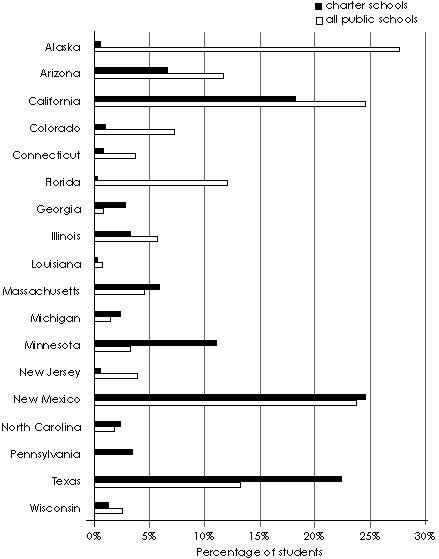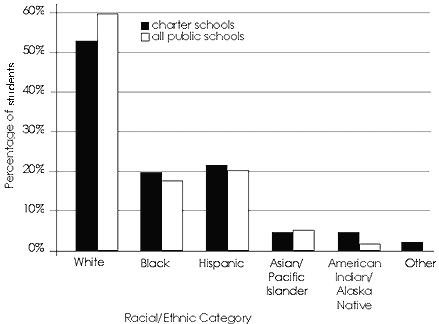
Archived Information
The State of Charter Schools Third-Year Report — May 1999Student Racial/Ethnic Composition
School Racial/Ethnic Distribution
Student Eligibility for Free And Reduced-Price Lunch
Students With Disabilities
Limited English Proficient Students
|
One fear regarding the charter movement is that charter schools will be elitist schools, serving a lower proportion of students of color than other public schools. Our research suggests that, in fact, most charter schools had about the same percentage of white students as their district average. More than 70 percent of charter schools were within 20 percent of the average district percentage of white students, while about 16 percent had a distinctly higher percentage of students of color than their surrounding district. The remaining 12 percent of schools had a lower percentage of students of color than their surrounding district. |
This table shows two methods for comparing the racial/ethnic composition of charter schools to the racial/ethnic composition of all public schools. Both methods indicate that charter schools have enrolled a slightly larger percentage of students of color than all public schools.
When the total number of students is used as the base for calculation, slightly more than half (52 percent) of the charter school students (in 1997-98) were white, compared to almost 60 percent white students in all public schools in the 24 charter states (in 1996-97). Charter schools were also slightly more likely to serve black, Hispanic, and American Indian students (19, 21, and 4 percent, respectively) compared to all public schools in the 24 charter states that served 17 percent black students, 19 percent Hispanic students, and 1 percent American Indian students.
Using the school as the base for calculation, the average estimated percentage of white students across charter schools (55 percent) was somewhat lower than the average percentage of white students across all public schools (63 percent). On average, charter schools enrolled a slightly larger percentage of black students (22 percent) than all public schools (16 percent).
| Racial/ethnic categories |
Students |
Schools |
|||||
|
# of students in category |
% of students in category |
Average of school % of students in racial category |
|||||
| Charter Schools | Public Schools | Charter Schools | Public Schools | Charter Schools | Public Schools | ||
|
Total1 |
27,886,307 |
|
|
589 |
49,316 | ||
|
White, not of Hispanic origin |
71,943 |
16,367,055 |
51.8% |
58.7% |
55.0% |
62.5% | |
|
Black, not of Hispanic origin |
26,393 |
4,680,563 |
19.0% |
16.8% |
22.0% |
16.0% | |
|
Hispanic |
28,554 |
5,395,949 |
20.6% |
19.3% |
15.7% |
16.6% | |
|
Asian or Pacific Islander |
5,157 |
1,164,334 |
3.7% |
4.2% |
2.5% |
3.3% | |
|
American Indian or Alaska Native |
5,310 |
278,392 |
3.8% |
1.0% |
4.0% |
1.6% | |
|
1,578 |
NA |
1.1% |
NA |
0.8% |
NA | ||
NOTE: These data rely on responses from 589 of 619 open charter schools that responded to the survey. The 589 schools were those with valid racial data; that is, schools where the number of students in the racial/ethnic categories was equal to the total student enrollment reported. Data from 30 schools were considered invalid for this analysis.
1These totals differ somewhat from totals presented earlier. The charter school total relies on 589 open charter schools as indicated above, while other figures utilize different numbers of schools. The total for all public schools differs from that presented in Exhibit 5 because it relies on data from different sources and different years.
2The National Center for Education Statistics does not report an "other" racial category.

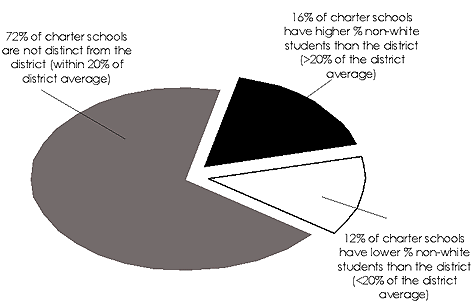
|
The states vary greatly in the racial/ethnic composition of their public school students, and charter schools generally mirror the state's racial composition. However, charter schools in 14 of the 24 charter states enrolled a considerably higher percentage of non-white students than do the other public schools. In some cases, this focus results from provisions in state law that target charter schools toward serving disadvantaged students. |
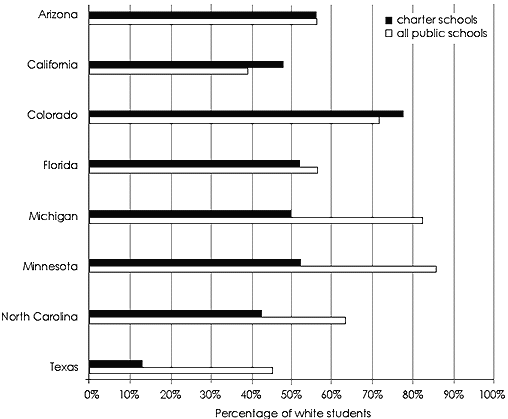
| State | # of schools | % White | % Black | % Hispanic | % Asian/ Pac. Is. |
% Am.Indian Alaska Ntv. |
% Other1 | |
| Alaska | charter | 10 | 81.6% | 2.3% | 1.1% | 3.2% | 11.6% | 0.2% |
| all public | 482 | 63.1% | 4.7% | 2.9% | 4.5% | 24.8% | ||
| Arizona | charter | 118 | 56.1% | 9.8% | 18.6% | 1.3% | 13.8% | 0.4% |
| all public | 1,281 | 56.7% | 4.3% | 30.1% | 1.8% | 7.1% | ||
| California | charter | 115 | 48.1% | 10.2% | 31.7% | 6.5% | 1.8% | 1.7% |
| all public | 7,980 | 39.5% | 8.7% | 39.7% | 11.2% | 0.9% | ||
| Colorado | charter | 46 | 77.9% | 5.7% | 13.0% | 2.2% | 1.2% | 0.0% |
| all public | 1,468 | 72.0% | 5.5% | 18.8% | 2.6% | 1.1% | ||
| Connecticut | charter | 11 | 27.0% | 49.7% | 22.9% | 0.1% | 0.3% | 0.0% |
| all public | 1,023 | 71.7% | 13.5% | 11.9% | 2.6% | 0.3% | ||
| Florida | charter | 29 | 51.8% | 41.3% | 4.9% | 1.2% | 0.7% | 0.1% |
| all public | 2,789 | 56.7% | 25.4% | 15.9% | 1.8% | 0.2% | ||
| Georgia | charter | 17 | 72.6% | 18.8% | 4.9% | 2.4% | 0.2% | 1.1% |
| all public | 1,798 | 57.9% | 37.7% | 2.6% | 1.7% | 0.1% | ||
| Illinois | charter | 6 | 16.6% | 60.5% | 22.5% | 0.2% | 0.2% | 0.0% |
| all public | 4,171 | 63.0% | 21.1% | 12.7% | 3.1% | 0.1% | ||
| Louisiana | charter | 6 | 32.2% | 64.8% | 1.1% | 0.6% | 0.9% | 0.4% |
| all public | 1,468 | 50.5% | 46.4% | 1.2% | 1.3% | 0.6% | ||
| Massachusetts | charter | 19 | 47.2% | 27.1% | 19.3% | 1.1% | 0.4% | 4.9% |
| all public | 1,810 | 77.9% | 8.5% | 9.4% | 0.4% | 0.2% | ||
| Michigan | charter | 92 | 49.9% | 42.8% | 3.8% | 0.9% | 2.4% | 0.2% |
| all public | 3,002 | 83.3% | 11.1% | 2.9% | 1.7%> | 1.0% | ||
| Minnesota | charter | 25 | 52.6% | 23.6% | 2.0% | 13.0% | 7.9% | 0.9% |
| all public | 1,785 | 86.4% | 5.2% | 2.2% | 4.2% | 2.0% | ||
| New Jersey | charter | 4 | 29.3% | 30.1% | 35.5% | 5.1% | 0.0% | 0.0% |
| all public | 2,278 | 62.5% | 18.5% | 13.5% | 5.3% | 0.2% | ||
| New Mexico | charter | 4 | 39.8% | 3.9% | 43.9% | 2.5% | 9.9% | 0.0% |
| all public | 729 | 38.6% | 2.4% | 47.5% | 1.06% | 10.5% | ||
| North Carolina | charter | 27 | 42.6% | 53.1% | 1.4% | 0.3% | 1.8% | 0.8% |
| all public | 1,997 | 63.9% | 30.8% | 2.3% | 1.5% | 1.5% | ||
| Pennsylvania | charter | 4 | 27.1% | 67.7% | 3.8% | 1.4% | 0.0% | 0.0% |
| all public | 3,110 | 80.2% | 14.2% | 3.7% | 1.8% | 0.1% | ||
| Texas | charter | 28 | 12.9% | 26.9% | 58.1% | 1.2% | 0.0% | 0.9% |
| all public | 6,875 | 45.6% | 14.3% | 37.4% | 2.4% | 0.3% | ||
| Wisconsin | charter | 17 | 73.6% | 19.4% | 3.1% | 3.1% | 0.7% | 0.1% |
| all public | 2,092 | 82.7% | 9.6% | 3.5% | 2.9% | 1.3% | ||
NOTE: These data rely on response from 578 out of the 619 open charter schools that responded to our survey. Of the 578 schools, 11 schools in six states (Delaware, District of Columbia, Hawaii, Kansas, Rhode Island, and South Carolina) have been omitted from this exhibit because each state has fewer than three charter schools and therefore numbers are small and percentages are not meaningful. All schools in this chart have valid racial data; that is, schools where the number of students in the racial/ethnic categories was equal to the total student enrollment reported.
SOURCE: U.S. Department of Education, National Center for Education Statistics, Common Core of Data Survey 199697 Early Release Files.
1 The National Center for Education Statistics does not report an "other" racial category.
|
Do charter schools serve the same proportion of economically disadvantaged students as other public schools? Students' eligibility for free or reduced-price lunch under the National School Lunch program is one measure of economic disadvantage that allows us to compare students in charter schools to those in all public schools. Charter schools serve a significantly higher proportion of economically disadvantaged students compared to all public schools in eight states. In some of those states, charter legislation targets low-income or at-risk students. Charter schools serve a distinctly lower proportion of economically disadvantaged students in three states. |
| Charter schools (1997-98) | All public schools (1994-95) | |||
| # eligible students | % of all students | # eligible students | % of all students | |
| Total | 53,970 | 36.7% | 10,146,087 | 37.6% |
| Alaska | 60 | 7.0% | 32,340 | 25.7% |
| Arizona | 9,640 | 39.4% | 284,357 | 40.1% |
| California | 17,820 | 35.4% | 2,257,008 | 42.4% |
| Colorado | 1,967 | 18.1% | 174,023 | 27.8% |
| Connecticut | 521 | 49.6% | 113,221 | 22.8% |
| Florida | 1,080 | 37.7% | 895,510 | 43.9% |
| Georgia | 3,803 | 29.4% | 501,824 | 40.6% |
| Illinois | 1,396 | 88.5% | 583,238 | 30.8% |
| Louisiana | 344 | 74.3% | 474,608 | 59.3% |
| Massachusetts | 2,490 | 45.1% | 225,110 | 25.6% |
| Michigan | 5,540 | 34.1% | 459747 | 28.7% |
| Minnesota | 1,502 | 52.5% | 217,376 | 26.8% |
| New Jersey | 201 | 43.1% | 326,022 | 28.3% |
| New Mexico | 1,167 | 30.1% | 159,740 | 49.6% |
| North Carolina | 1,465 | 40.1% | 413,729 | 36.5% |
| Pennsylvania | 399 | 69.3% | 541,793 | 31.1% |
| Texas | 3,456 | 68.7% | 1,662,900 | 46.1% |
| Wisconsin | 438 | 27.6% | 210,011 | 24.9% |
NOTE: The total number of students eligible for free and reduced-price lunch is based on 566 of the 619 open charter schools that responded to the survey. Of the 566 schools, nine schools in six states (DE, DC, HI, KS, RI, and SC) are not displayed in the table because each state has three or fewer charter schools and percentages are not meaningful. The "Total" row includes data from all 24 charter states, including the six states not included in the table. For each state, the percentage of students eligible for free and reduced-price lunch is computed by dividing the number of eligible students by the total number of students enrolled in schools in that state.
SOURCE: The percentage of students in all public schools eligible for free and reduced-price lunch was computed using two sources. The source for the numerator (eligibility counts by state) were the U.S. Department of Agriculture, Food, Nutrition, and Consumer Services, Program Information Division, for the 1994-95 school year. The data for the denominator (total student enrollment) were derived from the 1997 Digest of Education Statistics, U.S. Department of Education, National Center for Education Statistics (Fall, 1993).

|
Although charter schools are freed from many of the state regulations that govern schools, they are still subject to laws requiring them to provide access to students with disabilities. Our previous reports have documented that some charter schools are specifically designed to serve students with disabilities. |
| Charter schools (1997-98) | All public schools (1996-97) | |||
| # of students | % of students | # of students | % of students | |
| Total | 12,243 | 8.3% | 3,185,443 | 11.2% |
| Alaska | 43 | 5.0% | 157,44 | 12.1% |
| Arizona | 1,730 | 7.1% | 71,742 | 0.9% |
| California | 3,576 | 7.1% | 528,273 | 9.4% |
| Colorado | 857 | 7.9% | 64,275 | 9.5% |
| Connecticut | 84 | 0.8% | 73,578 | 1.4% |
| Florida | 720 | 25.1% | 295,762 | 13.2% |
| Georgia | 1,122 | 8.7% | 126,856 | 9.4% |
| Illinois | 172 | 10.9% | 239,415 | 12.1% |
| Louisiana | 30 | 6.5% | 83,277 | 10.5% |
| Massachusetts | 546 | 9.9% | 144,488 | 15.5% |
| Michigan | 853 | 5.3% | 175,219 | 10.5% |
| Minnesota | 491 | 17.2% | 90,353 | 11.4% |
| New Jersey | 10 | 2.1% | 185,635 | 15.5% |
| New Mexico | 673 | 17.4% | 44,440 | 13.5% |
| North Carolina | 523 | 14.3% | 137,013 | 11.3% |
| Pennsylvania | 77 | 13.4% | 94,953 | 10.8% |
| Texas | 362 | 7.2% | 428,859 | 11.2% |
| Wisconsin | 137 | 8.6% | 96,489 | 11.0% |
NOTE: The total number of students with disabilities is based on 554 of the 619 open charter schools that responded to the survey, although the exhibit does not show breakdowns for states with three or fewer charter schools. The percentage of students with disabilities in Florida is inflated by one school that reported large numbers of charter students with disabilities. The total number of students with disabilities is based on 554 of the 619 open charter schools that responded to the survey. Of the 554 schools, an additional ten schools in six states (Delaware, District of Columbia, Hawaii, Kansas, Rhode Island, and South Carolina) are not displayed in the table because each state still has three or fewer charter schools and percentages are not meaningful. The "Total" row includes data from all 24 charter states, including the six states not included in the table.
SOURCE: The national figures rely on two sources. The source for the numerator (the number of students served under IDEA) was: Twentieth Annual Report to Congress of the Implementation of the Individuals with Disabilities Education Act, U.S. Department of Education, (forthcoming). The source for the denominator (enrollment in the 24 charter states) was U.S. Department of Education, National Center for Education Statistics, Common Core of Data Survey, 199697 Early Release Files.
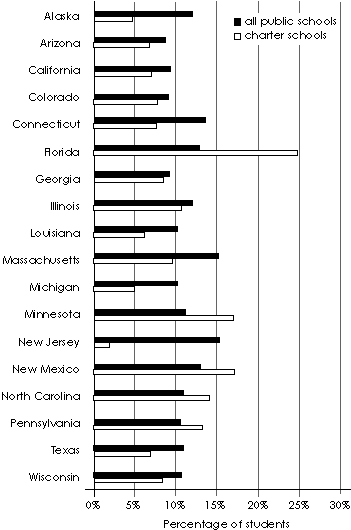
|
Limited English Proficient (LEP) students are concentrated in a few states in both charter and all public schools. Across the 24 charter states, the percentage of LEP students in charter schools is similar to that of all public schools, but the state-by-state picture reveals great variation. |
| State | Estimated LEP students | |||
| Charter schools (1997-98) | All public schools (1994-95) | |||
| # of students | % of students | # of students | % of students | |
| Total1 | 14,856 | 10.1% | 2,814,982 | 10.7% |
| Alaska | 6 | 0.7% | 34,942 | 27.7% |
| Arizona | 1,643 | 6.7% | 93,528 | 11.9% |
| California | 9,208 | 18.3% | 1,381,393 | 24.6% |
| Colorado | 120 | 1.1% | 24,675 | 7.4% |
| Connecticut | 8 | 0.8% | 19,819 | 3.8% |
| Florida | 7 | 0.2% | 288,603 | 12.2% |
| Georgia | 382 | 0.3% | 14,339 | 1.1% |
| Illinois | 54 | 3.4% | 118,246 | 0.6% |
| Louisiana | 2 | 0.4% | 6,494 | 0.9% |
| Massachusetts | 339 | 6.1% | 44,394 | 4.7% |
| Michigan | 407 | 2.5% | 25,988 | 1.6% |
| Minnesota | 321 | 11.2% | 28,237 | 3.4% |
| New Jersey | 3 | 0.6% | 49,300 | 0.4% |
| New Mexico | 954 | 24.6% | 78,107 | 2.4% |
| North Carolina | 90 | 2.5% | 24,771 | 0.2% |
| Pennsylvania | 20 | 3.5% | NA | NA |
| Texas | 1,140 | 22.7% | 513,634 | 13.4% |
| Wisconsin | 22 | 1.4% | 23,270 | 2.6% |
NOTE: The total number of LEP students is based on 611 of the 619 open charter schools that responded to the survey, although the exhibit does not show breakdowns for states with three or fewer charter schools. For each state, the percentage of LEP charter school students is computed by dividing the number of LEP students by the total number of enrolled students. The total number of LEP students is based on 611 of the 619 open charter schools that responded to the survey. Of the 611 schools, an additional nine schools in six states (Delaware, District of Columbia, Hawaii, Kansas, Rhode Island, and South Carolina) are not displayed in the table because each states has three or fewer charter schools and the percentages are not meaningful. . The "Total" row includes data from all 24 charter states, including the six states not included in the table.
SOURCE: Office of Bilingual Education and Minority Languages Affairs, Summary Report of the Survey of the States Limited English Proficient Students and Available Educational Programs and Services 19961997: Washington, DC: U.S. Department of Education, 1998.
1 The total excludes data from the state of Pennsylvania, which did not report information on LEP students for all public schools.
